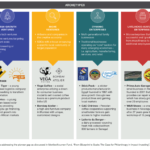How Perceptions of Risk May Be Creating The “Missing-Middle” Funding Gap
Understanding the challenges SMEs face in accessing capital in emerging markets is a well-trodden field of endeavor. Most interventions to remedy this, if not all, are focused on the SMEs themselves, as they are perceived to be the principal drivers and bearers of risk. It is this perception that shapes most SMEs’ reality. After all, investors push money through markets to where they perceive risk to be commensurate with reward. Perception, though, is not the sole influencer of reality. Facts still matter. Considering those facts, the prevailing view of SMEs’ challenging access to funding just might be wrongly conceived. What if the problem is not with the SMEs, but instead lies with the capital providers and their understanding of risk? We believe the conventional perception of risk wrongly reinforces poor access to funding, and that a more accurate understanding of risk will lessen this barrier to capital.
Unless perception and facts are bundled together, there is a real risk that investors will not understand the true risk and rewards of the markets in which they operate. This is crucially apparent in impact investing in emerging markets, particularly Sub-Saharan Africa. Investors who, through an impact investment, set their sights on a “socially appropriate return,” rather than the traditional “risk-adjusted return,” have the capacity to not only reduce the risk of an individual investment, but also to influence the risk environment of emerging markets. The consequence is wide-ranging benefit for all.
Nothing ventured, nothing gained
Risk is baked into almost every endeavor, investing included. Ask any finance professional what the most fundamental concept of investing is, and you are likely to get some variation of the “risk versus return” thesis: the higher the risk, the higher return one must seek. Investment risk is generally assessed as being the sum of both the risk of the individual project into which the investment is placed and the risk of the environment in which that vehicle exists. An environment such as, say, Silicon Valley, demands bold risk-taking by entrepreneurs in order to stand out in an area rich with innovators. Moreover, the resulting innovations have the capacity to generate extraordinary wealth almost overnight. As a result of the sheer volume of opportunities, and their potential upsides, capital is plentiful and therefore priced relatively cheaply. Taking risks fosters recognition, admiration and peer support. This makes risk a badge of honor, quite apart from any monetary fortune that might favor the bravery of the risk-taking.
However, in the emerging markets of Sub-Saharan Africa, risk is often treated with suspicion and heightened concern by investors. There is good reason for that. Sadly, a combination of colonial abuse and independent misrule has seen to it that most African nations suffer from great absences: a weakness of institutions, poor public goods delivery and often-crumbling infrastructure. Almost every capital city in Africa is struggling with inequality and a lack of housing, sanitation, power generation and adequately functioning markets. The systems that do function are fragile. Risk is everywhere. With that, it follows that the cost of capital must be more expensive for projects here, in these riskier economies, than elsewhere. But what if by the very act of investing, the overall risk is lowered? What if this in itself is a form of social return, or impact?
Answers to these questions may help impact investors aiming to raise a fund to deploy low-cost capital to SMEs in the emerging markets of Africa. In attempting to raise capital, such investors encounter the obstacle of two prevailing arguments made by other investors. First, it is often argued that investments present too high a risk to lend at any cost of capital. This results in many funders eschewing emerging markets in their entirety. Second, even if the possibility of lending is considered, the cost of debt commensurate with the risk creditors perceive they will be taking often settles at a minimum level beneath which creditors are unwilling to go. This de facto floor is often at a level too far out of reach for an entrepreneur, resulting in the “missing middle” funding gap. Regardless of which argument is of greater applicability on the facts, the entrepreneur is stymied in their attempt to secure capital.
Therefore, on this traditional, risk-adjusted return investment model, capital remains in short supply. In so doing, investors sell themselves – and these emerging markets – short. Risks remain high in these economies partly because of investors’ current understanding and perception of risk. If investors were to shift their understanding and perception of risk, they may see that traditional calculations of risk fail to include the future risk mitigation caused by strengthening the system. Impact investing can be the key to improving that environment.
Investing to reduce systemic risk: socially-appropriate returns
Impact investing has the tandem purpose of bringing about a beneficial social impact and a worthwhile financial return to the investor. Despite this bright-eyed intention, impact investing lags as an investment vehicle. That’s because, first, it is difficult to identify an investment project that will make an impact in its social environment. Secondly, even if such a project is identified, an investment that – in trying to profit maximize – attempts to extract more from the market than the market is capable of delivering, will collapse the market before the social gains are harvested. This is the problem with impact investing that seeks to create social returns as well as market-based financial ones. These are not insurmountable problems, however. With a fuller view on the system at play, impact investments do have the capacity not only to yield positive returns, but to shape an environment for the better, too.
Investment risk is lowered by a combination of certainty and security. It is the strong consensus of financial, political, and development analysts that African economies will only move from low-income economies to middle-income economies with strategies based on a high level of job and skills absorption, and when the surrounding environment of the local economy is sustainable and not extractive. Thereafter, in order to stay in that middle-income bracket and not slip backwards, those economies must also grow in a manner that is more equal and more inclusive of the wider populations that they serve.
Crucial to this is funders and investors seeking to judge an investment based on what we call a “socially-appropriate return”, rather than the conventional “risk-adjusted return.” The latter assesses the extant (and perceived) risk of the project, assigns a cost of money linked to that, and then imposes this cost onto the investment/project. Often the cost of the debt is higher than the returns that are currently generated by the project (resulting in the “missing middle” gap) and the only way to cover the debt cost is to profit maximize. This in turn often forces entrepreneurs to choose between existing social impact (such as education provision, transport for workers, higher wages) and meeting the new, debt-imposed return requirement. This curtailing of social impact ironically makes the system riskier, as it puts higher pressure on social services and ratchets up social pressure around service provision, inequality, and excludes new entrants into the market. In essence, it becomes an extractive funding model. This lens understands the true nature and impact of the project in itself, its far-reaching social stabilizing effects and provides a cost of debt that is lower and encourages social impact rather than forcing the entrepreneur to choose between it and profit maximization.
This kind of more appropriate level of costing money has two effects: First, the immediate effect of the lower cost of debt is to make the investment project less risky by ensuring the pressure on liquidity and solvency is not increased through a higher debt burden. Second, the later – and consequential – effect of the growing investment is to make the investment environment that it inhabits less risky through the social and societal impact it creates. This second effect, in turn feeds back to the first effect. As risk in the market lowers, it creates an increasingly stable environment and the other investments improve their risk-status even more. A perfect positive feedback loop is created.
An illustrative example: Oxen vs unicorns
At the core of Africa’s future growth lie the thousands of SMEs that dominate the business space across the continent. For most, an injection of expansion funding will admittedly not generate a much more significant return for investors – at least in the short term. They will simply continue to chug along, yielding around a 4–8% return per year, slowly growing, paying taxes, hiring more people, and, in a number of cases, will provide public goods on a level that takes on a semi-state quality. These SMEs hold African business – and societies – together. They have the quality of acting as the social glue. Reuben Coulter, CEO of the Transnational Business Network, spent several years in Nairobi immersed in this market and coined the phrase “oxen” to describe these types of business. It is a good African counterpoint to Silicon Valley’s “unicorns” and has special meaning in Africa.
Oxen are do-anything, go-anywhere, carry-everything, damn-the-distance creatures that can absorb a lot of punishment before they baulk. “Oxen” as an investment profile are similarly slow, reliable and with wide, broad, and deep impact in their ability to employ people and provide fair wages – acting as anchors of the community. In their thousands, they give rise to economic systems that are fair, just, equitable and, most importantly, strong and stable.
“Oxen” will yield not the traditional “risk-adjusted return” but rather a “societally-appropriate return” that continues to plough back into their society in a non profit-maximizing way. Instead of these SMEs persistently holding inherent risk, they are transformed into the very opposite. Investment in them strengthens their individual standing. These SMEs provide the seeds of economic transformation and so become risk mitigating, not risk enhancing. But this cycle never begins when SMEs are considered too risky.
Changing our understanding of risk
To end, let us go back to the beginning. Perception and facts shape reality. New possibilities are brought about by adding facts and changing perceptions. In the investment sphere, SMEs in emerging markets might appear a high-risk proposition. However, by investing in these SMEs, a new investment environment is crafted, one where risk is reduced both in the SME and in the environment in which the SME lives and breathes. Perceptions shape reality, so when we change the perception around risk, so too will the reality change.
Clint Bartlett is Investment Director at the Transformational Business Network.
Michael Eastman is a human rights lawyer in South Africa and the United States.
Photo courtesy of Marcus Spiske.
- Categories
- Investing
- Tags
- impact investing



